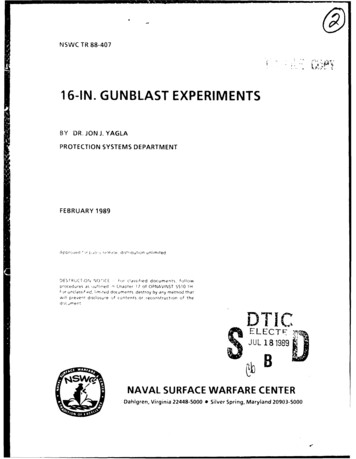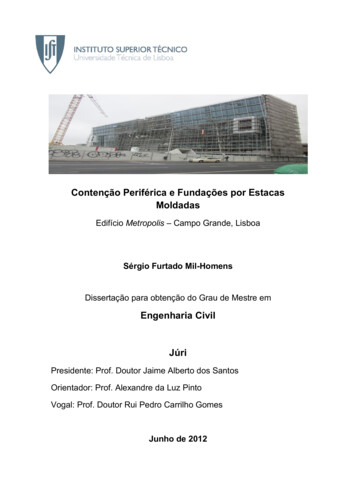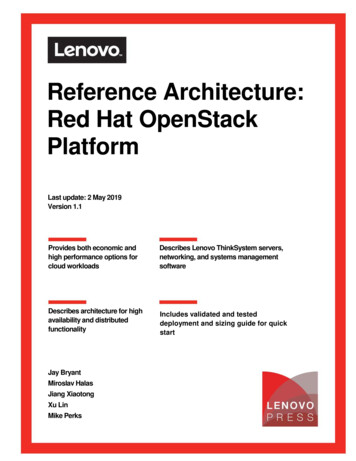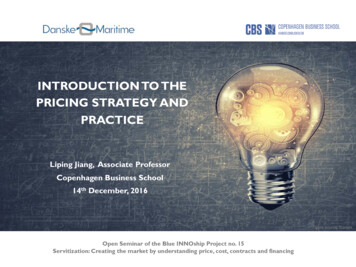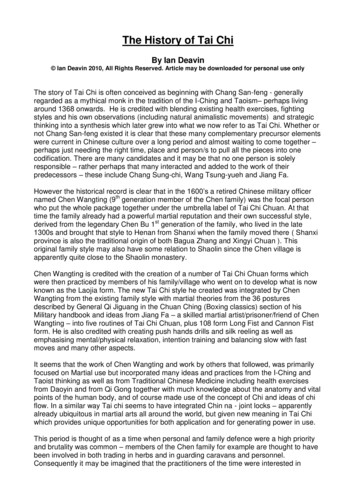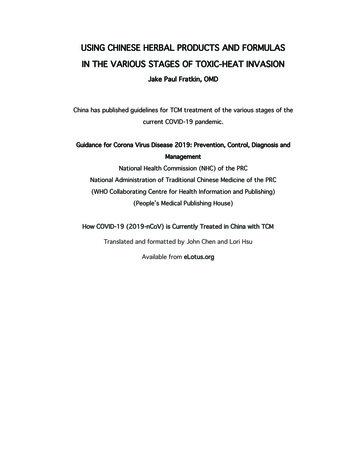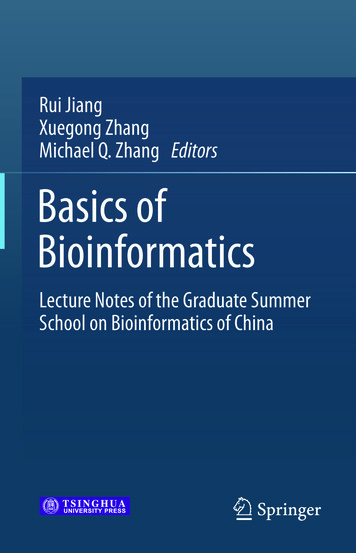
Transcription
Rui JiangXuegong ZhangMichael Q. Zhang EditorsBasics ofBioinformaticsLecture Notes of the Graduate SummerSchool on Bioinformatics of China
Basics of Bioinformatics
Rui Jiang Xuegong Zhang Michael Q. ZhangEditorsBasics of BioinformaticsLecture Notes of the Graduate SummerSchool on Bioinformatics of China123
EditorsRui JiangXuegong ZhangDepartment of AutomationTsinghua UniversityBeijingChina, People’s RepublicMichael Q. ZhangDepartment of Molecular and Cell BiologyThe University of Texas at DallasRichardson, TX, USATsinghua National Laboratoryfor Information Science and TechnologyTsinghua UniversityBeijing, China, People’s RepublicISBN 978-3-642-38950-4ISBN 978-3-642-38951-1 (eBook)DOI 10.1007/978-3-642-38951-1Springer Heidelberg New York Dordrecht LondonJointly published with Tsinghua University Press, BeijingISBN: 978-7-302-32359-4 Tsinghua University Press, BeijingLibrary of Congress Control Number: 2013950934 Tsinghua University Press, Beijing and Springer-Verlag Berlin Heidelberg 2013This work is subject to copyright. All rights are reserved by the Publishers, whether the whole or part ofthe material is concerned, specifically the rights of translation, reprinting, reuse of illustrations, recitation,broadcasting, reproduction on microfilms or in any other physical way, and transmission or informationstorage and retrieval, electronic adaptation, computer software, or by similar or dissimilar methodologynow known or hereafter developed. Exempted from this legal reservation are brief excerpts in connectionwith reviews or scholarly analysis or material supplied specifically for the purpose of being enteredand executed on a computer system, for exclusive use by the purchaser of the work. Duplication ofthis publication or parts thereof is permitted only under the provisions of the Copyright Law of thePublishers’ locations, in its current version, and permission for use must always be obtained fromSpringer. Permissions for use may be obtained through RightsLink at the Copyright Clearance Center.Violations are liable to prosecution under the respective Copyright Law.The use of general descriptive names, registered names, trademarks, service marks, etc. in this publicationdoes not imply, even in the absence of a specific statement, that such names are exempt from the relevantprotective laws and regulations and therefore free for general use.While the advice and information in this book are believed to be true and accurate at the date ofpublication, neither the authors nor the editors nor the publishers can accept any legal responsibilityfor any errors or omissions that may be made. The publishers make no warranty, express or implied, withrespect to the material contained herein.Printed on acid-free paperSpringer is part of Springer Science Business Media (www.springer.com)
ForewordThis ambitious volume is the result of the successful 2007 Graduate SummerSchool on Bioinformatics of China held at Tsinghua University. It is remarkablefor its range of topics as well as the depth of coverage. Bioinformatics draws onmany subjects for analysis of the data generated by the biological sciences andbiotechnology. This foreword will describe briefly each of the 12 chapters and closewith additional general comments about the field. Many of the chapters overlap andinclude useful introductions to concepts such as gene or Bayesian methods. This isa valuable aspect of the volume allowing a student various angles of approach to anew topic.Chapter 1, “Basics for Bioinformatics,” defines bioinformatics as “the storage,manipulation and interpretation of biological data especially data of nucleic acidsand amino acids, and studies molecular rules and systems that govern or affectthe structure, function and evolution of various forms of life from computationalapproaches.” Thus, the first subject they turn to is molecular biology, a subject thathas had an enormous development in the last decades and shows no signs of slowingdown. Without a basic knowledge of biology, the bioinformatics student is greatlyhandicapped. From basic biology the authors turn to biotechnology, in particular,methods for DNA sequencing, microarrays, and proteomics. DNA sequencing isundergoing a revolution. The mass of data collected in a decade of the HumanGenome Project from 1990 to 2001 can be generated in 1 day in 2010. This ischanging the science of biology at the same time. A 1,000 genome project becamea 10,000 genome project 2 years later, and one expects another zero any time now.Chromatin Immunoprecipitation or ChIP allows access to DNA bound by proteinsand thus to a large number of important biological processes. Another topic underthe umbrella of biological sciences is genetics, the study of heredity and inheritedcharacteristics (phenotypes). Heredity is encoded in DNA and thus is closely relatedto the goals of bioinformatics. This whole area of genetics beginning with Mendel’slaws deserves careful attention, and genetics is a key aspect of the so-called geneticmapping and other techniques where the chromosomal locations of disease genesare sought.v
viForewordChapter 2, “Basic Statistics for Bioinformatics,” presents important materialfor the understanding and analysis of data. Probability and statistics are basicto bioinformatics, and this chapter begins with the fundamentals including manyclassical distributions (including the binomial, Poisson, and normal). Usually theobservation of complete populations such as “all people in China over 35 yearsold” is not practical to obtain. Instead random samples of the population of interestare obtained and then inferences about parameters of the population are made.Statistics guides us in making those inferences and gaining information aboutthe quality of the estimates. The chapter describes techniques such as method ofmoments, maximum likelihood, and Bayesian methods. Bayesian methods havebecome indispensable in the era of powerful computing machines. The chapter treatshypothesis testing which is less used than parameter estimation, but hypothesistesting provides understanding of p-values which are ubiquitous in bioinformaticsand data analysis. Classical testing situations reveal useful statistics such as thet-statistic. Analysis of variance and regression analysis are crucial for testing andfitting large data sets. All of these methods and many more are included in the freeopen-source package called R.Chapter 3, “Topics in Computational Genomics,” takes us on a tour of importanttopics that arise when complete genome information is available. The subject didnot begin until nearly 2000 when complete genome sequences became a possibility.The authors present us with a list of questions, some of which are listed next.What are the genes of an organism? How are they turned off and on? How do theyinteract with each other? How are introns and exons organized and expressed inRNA transcripts? What are the gene products, both structure and function? How hasa genome evolved? This last question has to be asked with other genomes and withmembers of the population comprising the species. Then the authors treat some ofthe questions in detail. They describe “finding protein coding genes,” “identifyingpromoters,” “genomic arrays and a CGH/CNP analysis,” “modeling regulatoryelements,” “predicting transcription factor binding sites,” and motif enrichment andanalysis. Within this last topic, for example, various word counting methods areemployed including the Bayesian methods of expectation maximization and Gibbssampling.An alert reader will have noticed the prominence of Bayesian methods in thepreceding paragraphs. Chapter 4, “Statistical Methods in Bioinformatics,” in thiscollection focuses on this subject. There is a nice discussion of statistical modelingand then Bayesian inference. Dynamic programming, a recursive method of optimization, is introduced and then employed in the development of Hidden MarkovModels (HMMs). Of course the basics of Markov chains must also be covered. TheMetropolis-Hastings algorithm, Monte Carlo Markov chains (MCMC), and Gibbssampling are carefully presented. Then these ideas find application in the analysisof microarray data. Here the challenging aspects of multiple hypothesis testingappear, and false discovery rate analysis is described. Hierarchical clustering andbi-clustering appear naturally in the context of microarray analysis. Then the issuesof sequence analysis (especially multiple sequence analysis) are approached usingthese HHM and Bayesian methods along with pattern discovery in the sequences.
ForewordviiDiscovering regulatory sequence patterns is an especially important topic in thissection. The topics of this chapter appear in computer science as “machine learning”or under “data mining”; here the subject is called statistical or Bayesian methods.Whatever it is named, this is an essential area for bioinformatics.The next chapter (Chap. 5), “Algorithms in Computational Biology,” takes upthe formal computational approach to our biological problems. It should be pointedout that the previous chapters contained algorithmic content, but there it was lessacknowledged. It is my belief that the statistical and algorithmic approaches gohand in hand. Even with the Euclid’s algorithm example of the present chapter,there are statistical issues nearby. For example, the three descriptions of Euclid’salgorithm are analyzed for time complexity. It is easy to ask how efficient thealgorithms are on randomly chosen pairs of integers. What is the expected runningtime of the algorithms? What is the variance? Amazingly these questions haveanswers which are rather deep. The authors soon turn to dynamic programming(DP), and once again they present clear illustrative examples, in this case Fibonaccinumbers. Designing DP algorithms for sequence alignment is covered. Then a morerecently developed area of genome rearrangements is described along with someof the impressive (and deep) results from the area. This topic is relevant to wholegenome analysis as chromosomes evolve on a larger scale than just alterations ofindividual letters as covered by sequence alignment.In Chap. 6, “Multivariate Statistical Methods in Bioinformatics Research,”we have a thorough excursion into multivariate statistics. This can be viewed asthe third statistical chapter in this volume. Here the multivariate normal distributionis studied in its many rich incarnations. This is justified by the ubiquitous natureof the normal distribution. Just as with the bell-shaped curve which appears in onedimension due to the central limit theorem (add up enough independent randomvariables and suitably normalized, one gets the normal under quite general conditions), there is also a multivariate central limit theorem. Here detailed propertiesare described as well as related distributions such as the Wishart distribution (theanalog of the chi-square). Estimation is relevant as is a multivariate t-test. Principalcomponent analysis, factor analysis, and linear discriminant analysis are all coveredwith some nice examples to illustrate the power of approaches. Then classificationproblems and variable selection both give platforms to further illustrate and developthe methods on important bioinformatics application areas.Chapter 7, “Association Analysis for Human Diseases: Methods and Examples,”gives us the opportunity to look more deeply into aspects of genetics. While thischapter emphasizes statistics, be aware that computational issues also drive muchof the research and cannot be ignored. Population genetics is introduced and thenthe important subjects of genetic linkage analysis and association studies. Genomicinformation such as single-nucleotide polymorphisms (SNPs) provide voluminousdata for many of these studies, where multiple hypothesis testing is a critical issue.Chapter 8, “Data Mining and Knowledge Discovery Methods with Case Examples,” deals with the area of knowledge discovery and data mining. To quote theauthors, this area “has emerged as an important research direction for extractinguseful information from vast repositories of data of various types. The basic
viiiForewordconcepts, problems and challenges deals with the area of knowledge discovery anddata mining that has emerged as an important research direction for extracting usefulinformation from vast repositories of data of various types. The basic concepts,problems and challenges are first briefly discussed. Some of the major data miningtasks like classification, clustering and association rule mining are then described insome detail. This is followed by a description of some tools that are frequently usedfor data mining. Two case examples of supervised and unsupervised classificationfor satellite image analysis are presented. Finally an extensive bibliography isprovided.”The valuable chapter on Applied Bioinformatics Tools (Chap. 9) provides a stepby-step description of the application tools used in the course and data sources aswell as a list of the problems. It should be strongly emphasized that no one learnsthis material without actually having hands-on experience with the derivations andthe applications. This is not a subject for contemplation only!Protein structure and function is a vast and critically important topic. In thiscollection it is covered by Chap. 10, “Foundations for the Study of Structure andFunction of Proteins.” There the detailed structure of amino acids is presentedwith their role in the various levels of protein structure (including amino acidsequence, secondary structure, tertiary structure, and spatial arrangements of thesubunits). The geometry of the polypeptide chain is key to these studies as are theforces causing the three-dimensional structures (including electrostatic and van derWaals forces). Secondary structural units are classified into ’-helix, “-sheets, and“-turns. Structural motifs and folds are described. Protein structure prediction is anactive field, and various approaches are described including homology modelingand machine learning.Systems biology is a recently described approach to combining system-wide dataof biology in order to gain a global understanding of a biological system, such asa bacterial cell. The science is far from succeeding in this endeavor in general,let alone having powerful techniques to understand the biology of multicellularorganisms. It is a grand challenge goal at this time. The fascinating chapter onComputational Systems Biology Approaches for Deciphering Traditional ChineseMedicine (Chap. 11) seeks to apply the computational systems biology (CSB)approach to traditional Chinese medicine (TCM). The chapter sets up parallelconcepts between CSB and CTM. In Sect. 11.3.2 the main focus is “on a CSB-basedcase study for TCM ZHENG—a systems biology approach with the combinationof computational analysis and animal experiment to investigate Cold ZHENG andHot ZHENG in the context of the neuro-endocrine-immune (NEI) system.” Withincreasing emphasis on the so-called nontraditional medicine, these studies havegreat potential to unlock new understandings for both CSB and TCM.Finally I close with a few remarks about this general area. Biology is a majorscience for our new century; perhaps it will be the major science of the twentyfirst century. However, if someone is not excited by biology, then they should find asubject that does excite them. I have almost continuously found the new discoveriessuch as introns or microRNA absolutely amazing. It is such a young science whensuch profound wonders keep showing up. Clearly no one analysis subject can
Forewordixsolve all the problems arising in modern computational molecular biology. Statisticsalone, computer science alone, experimental molecular biology alone, none of theseare sufficient in isolation. Protein structure studies require an entire additional setof tools such as classical mechanics. And as systems biology comes into play,systems of differential equations and scientific computing will surely be important.None of us can learn everything, but everyone working in this area needs a set ofwell-understood tools. We all learn new techniques as we proceed, learning thingsrequired to solve the problems. This requires people who evolve with the subject.This is exciting, but I admit it is hard work too. Bioinformatics will evolve as itconfronts new data created by the latest biotechnology and biological sciences.University of Southern CaliforniaLos Angeles, USAMarch 2, 2013Michael S. Waterman
Contents12Basics for Bioinformatics . . . . . . . . . . . . . . . . . . . . . . . . . . . . . . . . . . . . . . . . . . . . . . . . . .Xuegong Zhang, Xueya Zhou, and Xiaowo Wang1.1What Is Bioinformatics . . . . . . . . . . . . . . . . . . . . . . . . . . . . . . . . . . . . . . . . . . . . .1.2Some Basic Biology . . . . . . . . . . . . . . . . . . . . . . . . . . . . . . . . . . . . . . . . . . . . . . . .1.2.1Scale and Time . . . . . . . . . . . . . . . . . . . . . . . . . . . . . . . . . . . . . . . . . . . .1.2.2Cells. . . . . . . . . . . . . . . . . . . . . . . . . . . . . . . . . . . . . . . . . . . . . . . . . . . . . . . .1.2.3DNA and Chromosome . . . . . . . . . . . . . . . . . . . . . . . . . . . . . . . . . . .1.2.4The Central Dogma . . . . . . . . . . . . . . . . . . . . . . . . . . . . . . . . . . . . . . .1.2.5Genes and the Genome. . . . . . . . . . . . . . . . . . . . . . . . . . . . . . . . . . . .1.2.6Measurements Along the Central Dogma . . . . . . . . . . . . . . . .1.2.7DNA Sequencing . . . . . . . . . . . . . . . . . . . . . . . . . . . . . . . . . . . . . . . . . .1.2.8Transcriptomics and DNA Microarrays . . . . . . . . . . . . . . . . . .1.2.9Proteomics and Mass Spectrometry . . . . . . . . . . . . . . . . . . . . . .1.2.10 ChIP-Chip and ChIP-Seq . . . . . . . . . . . . . . . . . . . . . . . . . . . . . . . . .1.3Example Topics of Bioinformatics . . . . . . . . . . . . . . . . . . . . . . . . . . . . . . . . .1.3.1Examples of Algorithmatic Topics . . . . . . . . . . . . . . . . . . . . . . .1.3.2Examples of Statistical Topics . . . . . . . . . . . . . . . . . . . . . . . . . . . .1.3.3Machine Learning and PatternRecognition Examples . . . . . . . . . . . . . . . . . . . . . . . . . . . . . . . . . . . .1.3.4Basic Principles of Genetics . . . . . . . . . . . . . . . . . . . . . . . . . . . . . .References . . . . . . . . . . . . . . . . . . . . . . . . . . . . . . . . . . . . . . . . . . . . . . . . . . . . . . . . . . . . . . . . . . . .Basic Statistics for Bioinformatics . . . . . . . . . . . . . . . . . . . . . . . . . . . . . . . . . . . . . . . .Yuanlie Lin and Rui Jiang2.1Introduction . . . . . . . . . . . . . . . . . . . . . . . . . . . . . . . . . . . . . . . . . . . . . . . . . . . . . . . . .2.2Foundations of Statistics. . . . . . . . . . . . . . . . . . . . . . . . . . . . . . . . . . . . . . . . . . . .2.2.1Probabilities . . . . . . . . . . . . . . . . . . . . . . . . . . . . . . . . . . . . . . . . . . . . . . .2.2.2Random Variables . . . . . . . . . . . . . . . . . . . . . . . . . . . . . . . . . . . . . . . . .2.2.3Multiple Random Variables . . . . . . . . . . . . . . . . . . . . . . . . . . . . . . .2.2.4Distributions . . . . . . . . . . . . . . . . . . . . . . . . . . . . . . . . . . . . . . . . . . . . . . .11233457101013161718181920212527272727303234xi
xii3Contents2.2.5Random Sampling. . . . . . . . . . . . . . . . . . . . . . . . . . . . . . . . . . . . . . . . .2.2.6Sufficient Statistics . . . . . . . . . . . . . . . . . . . . . . . . . . . . . . . . . . . . . . . .2.3Point Estimation . . . . . . . . . . . . . . . . . . . . . . . . . . . . . . . . . . . . . . . . . . . . . . . . . . . .2.3.1Method of Moments. . . . . . . . . . . . . . . . . . . . . . . . . . . . . . . . . . . . . . .2.3.2Maximum Likelihood Estimators . . . . . . . . . . . . . . . . . . . . . . . .2.3.3Bayes Estimators . . . . . . . . . . . . . . . . . . . . . . . . . . . . . . . . . . . . . . . . . .2.3.4Mean Squared Error . . . . . . . . . . . . . . . . . . . . . . . . . . . . . . . . . . . . . . .2.4Hypothesis Testing . . . . . . . . . . . . . . . . . . . . . . . . . . . . . . . . . . . . . . . . . . . . . . . . . .2.4.1Likelihood Ratio Tests . . . . . . . . . . . . . . . . . . . . . . . . . . . . . . . . . . . .2.4.2Error Probabilities and the Power Function . . . . . . . . . . . . . .2.4.3p-Values. . . . . . . . . . . . . . . . . . . . . . . . . . . . . . . . . . . . . . . . . . . . . . . . . . . .2.4.4Some Widely Used Tests . . . . . . . . . . . . . . . . . . . . . . . . . . . . . . . . .2.5Interval Estimation . . . . . . . . . . . . . . . . . . . . . . . . . . . . . . . . . . . . . . . . . . . . . . . . . .2.6Analysis of Variance . . . . . . . . . . . . . . . . . . . . . . . . . . . . . . . . . . . . . . . . . . . . . . . .2.6.1One-Way Analysis of Variance . . . . . . . . . . . . . . . . . . . . . . . . . . .2.6.2Two-Way Analysis of Variance . . . . . . . . . . . . . . . . . . . . . . . . . . .2.7Regression Models . . . . . . . . . . . . . . . . . . . . . . . . . . . . . . . . . . . . . . . . . . . . . . . . . .2.7.1Simple Linear Regression. . . . . . . . . . . . . . . . . . . . . . . . . . . . . . . . .2.7.2Logistic Regression . . . . . . . . . . . . . . . . . . . . . . . . . . . . . . . . . . . . . . .2.8Statistical Computing Environments . . . . . . . . . . . . . . . . . . . . . . . . . . . . . . .2.8.1Downloading and Installation . . . . . . . . . . . . . . . . . . . . . . . . . . . .2.8.2Storage, Input, and Output of Data . . . . . . . . . . . . . . . . . . . . . . .2.8.3Distributions . . . . . . . . . . . . . . . . . . . . . . . . . . . . . . . . . . . . . . . . . . . . . . .2.8.4Hypothesis Testing . . . . . . . . . . . . . . . . . . . . . . . . . . . . . . . . . . . . . . . .2.8.5ANOVA and Linear Model . . . . . . . . . . . . . . . . . . . . . . . . . . . . . . .References . . . . . . . . . . . . . . . . . . . . . . . . . . . . . . . . . . . . . . . . . . . . . . . . . . . . . . . . . . . . . . . . . . . 868Topics in Computational Genomics . . . . . . . . . . . . . . . . . . . . . . . . . . . . . . . . . . . . . .Michael Q. Zhang and Andrew D. Smith3.1Overview: Genome Informatics . . . . . . . . . . . . . . . . . . . . . . . . . . . . . . . . . . . .3.2Finding Protein-Coding Genes . . . . . . . . . . . . . . . . . . . . . . . . . . . . . . . . . . . . .3.2.1How to Identify a Coding Exon? . . . . . . . . . . . . . . . . . . . . . . . . .3.2.2How to Identify a Gene with Multiple Exons? . . . . . . . . . .3.3Identifying Promoters. . . . . . . . . . . . . . . . . . . . . . . . . . . . . . . . . . . . . . . . . . . . . . .3.4Genomic Arrays and aCGH/CNP Analysis. . . . . . . . . . . . . . . . . . . . . . . .3.5Introduction on Computational Analysisof Transcriptional Genomics Data . . . . . . . . . . . . . . . . . . . . . . . . . . . . . . . . .3.6Modeling Regulatory Elements . . . . . . . . . . . . . . . . . . . . . . . . . . . . . . . . . . . .3.6.1Word-Based Representations . . . . . . . . . . . . . . . . . . . . . . . . . . . . .3.6.2The Matrix-Based Representation . . . . . . . . . . . . . . . . . . . . . . . .3.6.3Other Representations. . . . . . . . . . . . . . . . . . . . . . . . . . . . . . . . . . . . .3.7Predicting Transcription Factor Binding Sites . . . . . . . . . . . . . . . . . . . . .3.7.1The Multinomial Model for Describing Sequences . . . . .3.7.2Scoring Matrices and Searching Sequences . . . . . . . . . . . . .696971727273757677777879798081
Contentsxiii3.7.3Algorithmic Techniques for IdentifyingHigh-Scoring Sites . . . . . . . . . . . . . . . . . . . . . . . . . . . . . . . . . . . . . . . .3.7.4Measuring Statistical Significance of Matches . . . . . . . . . .3.8Modeling Motif Enrichment in Sequences . . . . . . . . . . . . . . . . . . . . . . . .3.8.1Motif Enrichment Based on Likelihood Models. . . . . . . . .3.8.2Relative Enrichment Between Two Sequence Sets . . . . . .3.9Phylogenetic Conservation of Regulatory Elements . . . . . . . . . . . . . .3.9.1Three Strategies for Identifying ConservedBinding Sites . . . . . . . . . . . . . . . . . . . . . . . . . . . . . . . . . . . . . . . . . . . . . .3.9.2Considerations When Using Phylogenetic Footprinting3.10Motif Discovery . . . . . . . . . . . . . . . . . . . . . . . . . . . . . . . . . . . . . . . . . . . . . . . . . . . . .3.10.1 Word-Based and Enumerative Methods . . . . . . . . . . . . . . . . . .3.10.2 General Statistical Algorithms Appliedto Motif Discovery . . . . . . . . . . . . . . . . . . . . . . . . . . . . . . . . . . . . . . . .3.10.3 Expectation Maximization . . . . . . . . . . . . . . . . . . . . . . . . . . . . . . . .3.10.4 Gibbs Sampling . . . . . . . . . . . . . . . . . . . . . . . . . . . . . . . . . . . . . . . . . . .References . . . . . . . . . . . . . . . . . . . . . . . . . . . . . . . . . . . . . . . . . . . . . . . . . . . . . . . . . . . . . . . . . . . .4Statistical Methods in Bioinformatics . . . . . . . . . . . . . . . . . . . . . . . . . . . . . . . . . . . .Jun S. Liu and Bo Jiang4.1Introduction . . . . . . . . . . . . . . . . . . . . . . . . . . . . . . . . . . . . . . . . . . . . . . . . . . . . . . . . .4.2Basics of Statistical Modeling and Bayesian Inference . . . . . . . . . . .4.2.1Bayesian Method with Examples. . . . . . . . . . . . . . . . . . . . . . . . .4.2.2Dynamic Programming and Hidden Markov Model . . . .4.2.3Metropolis–Hastings Algorithm and Gibbs Sampling . .4.3Gene Expression and Microarray Analysis . . . . . . . . . . . . . . . . . . . . . . . .4.3.1Low-Level Processing and DifferentialExpression Identification. . . . . . . . . . . . . . . . . . . . . . . . . . . . . . . . . .4.3.2Unsupervised Learning . . . . . . . . . . . . . . . . . . . . . . . . . . . . . . . . . . .4.3.3Dimension Reduction Techniques . . . . . . . . . . . . . . . . . . . . . . . .4.3.4Supervised Learning . . . . . . . . . . . . . . . . . . . . . . . . . . . . . . . . . . . . . .4.4Sequence Alignment . . . . . . . . . . . . . . . . . . . . . . . . . . . . . . . . . . . . . . . . . . . . . . . .4.4.1Pair-Wise Sequence Analysis . . . . . . . . . . . . . . . . . . . . . . . . . . . . .4.4.2Multiple Sequence Alignment . . . . . . . . . . . . . . . . . . . . . . . . . . . .4.5Sequence Pattern Discovery . . . . . . . . . . . . . . . . . . . . . . . . . . . . . . . . . . . . . . . .4.5.1Basic Models and Approaches. . . . . . . . . . . . . . . . . . . . . . . . . . . .4.5.2Gibbs Motif Sampler . . . . . . . . . . . . . . . . . . . . . . . . . . . . . . . . . . . . . .4.5.3Phylogenetic Footprinting Methodand the Identification of Cis-Regulatory Modules . . . . . . .4.6Combining Sequence and Expression Informationfor Analyzing Transcription Regulation . . . . . . . . . . . . . . . . . . . . . . . . . . .4.6.1Motif Discovery in ChIP-Array Experiment . . . . . . . . . . . . .4.6.2Regression Analysis of Transcription Regulation . . . . . . .4.6.3Regulatory Role of Histone Modification . . . . . . . . . . . . . . . 110113117119126126129133133136138140140141143
xiv56Contents4.7Protein Structure and Proteomics . . . . . . . . . . . . . . . . . . . . . . . . . . . . . . . . . .4.7.1Protein Structure Prediction . . . . . . . . . . . . . . . . . . . . . . . . . . . . . .4.7.2Protein Chip Data Analysis . . . . . . . . . . . . . . . . . . . . . . . . . . . . . . .References . . . . . . . . . . . . . . . . . . . . . . . . . . . . . . . . . . . . . . . . . . . . . . . . . . . . . . . . . . . . . . . . . . . .144145146147Algorithms in Computational Biology . . . . . . . . . . . . . . . . . . . . . . . . . . . . . . . . . . .Tao Jiang and Jianxing Feng5.1Introduction . . . . . . . . . . . . . . . . . . . . . . . . . . . . . . . . . . . . . . . . . . . . . . . . . . . . . . . . .5.2Dynamic Programming and Sequence Alignment . . . . . . . . . . . . . . . .5.2.1The Paradigm of Dynamic Programming . . . . . . . . . . . . . . . .5.2.2Sequence Alignment . . . . . . . . . . . . . . . . . . . . . . . . . . . . . . . . . . . . . .5.3Greedy Algorithms for Genome Rearrangement . . . . . . . . . . . . . . . . . .5.3.1Genome Rearrangements . . . . . . . . . . . . . . . . . . . . . . . . . . . . . . . . .5.3.2Breakpoint Graph, Greedy Algorithm andApproximation Algorithm . . . . . . . . . . . . . . . . . . . . . . . . . . . . . . . .References . . . . . . . . . . . . . . . . . . . . . . . . . . . . . . . . . . . . . . . . . . . . . . . . . . . . . . . . . . . . . . . . . . . .151Multivariate Statistical Methods in Bioinformatics Research . . . . . . . . .Lingsong Zhang and Xihong Lin6.1Introduction . . . . . . . . . . . . . . . . . . . . . . . . . . . . . . . . . . . . . . . . . . . . . . . . . . . . . . . . .6.2Multivariate Normal Distribution . . . . . . . . . . . . . . . . . . . . . . . . . . . . . . . . . .6.2.1Definition and Notation . . . . . . . . . . . . . . . . . . . . . . . . . . . . . . . . . . .6.2.2Properties of the Multivariate NormalDistribution . . . . . . . . . . . . . . . . . . . . . . . . . . . . . . . . . . . . . . . . . . . . . . .6.2.3Bivariate Normal Distribution . . . . . . . . . . . . . . . . . . . . . . . . . . . .6.2.4Wishart Distribution. . . . . . . . . . . . . . . . . . . . . . . . . . . . . . . . . . . . . . .6.2.5Sample Mean and Covariance . . . . . . . . . . . . . . . . . . . . . . . . . . .6.3One-Sample and Two-Sample Multivariate Hypothesis Tests . . . .6.3.1One-Sample t Test for a Univariate Outcome . . . . . . . . . . .6.3.2Hotelling’s T 2 Test for the MultivariateOutcome . . . . . . . . . . . . . . . . . . . . . . . . . . . . . . . . . . . . . . . . . . . . . . . . . .6.3.3Properties of Hotelling’s T 2 Test . . . . . . . . . . . . . . . . . . . . . . . . .6.3.4Paired Multivariate Hotelling’s T 2 Test . . . . . . . . . . . . . . . . . .6.3.5Examples . .
China, People’s Republic Michael Q. Zhang Department of Molecular and Cell Biology The University of Texas at Dallas Richardson, TX, USA Tsinghua National Laboratory for Information Science and Technology Tsinghua University Beijing, China, People’s Republic ISBN 978-3-642-38950-4 ISBN 978-3-642-38951

